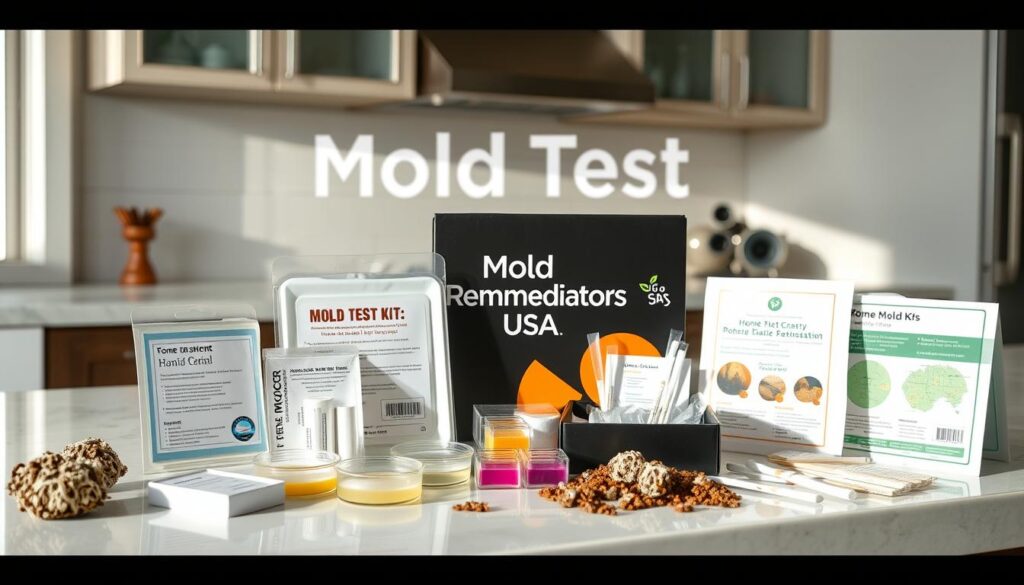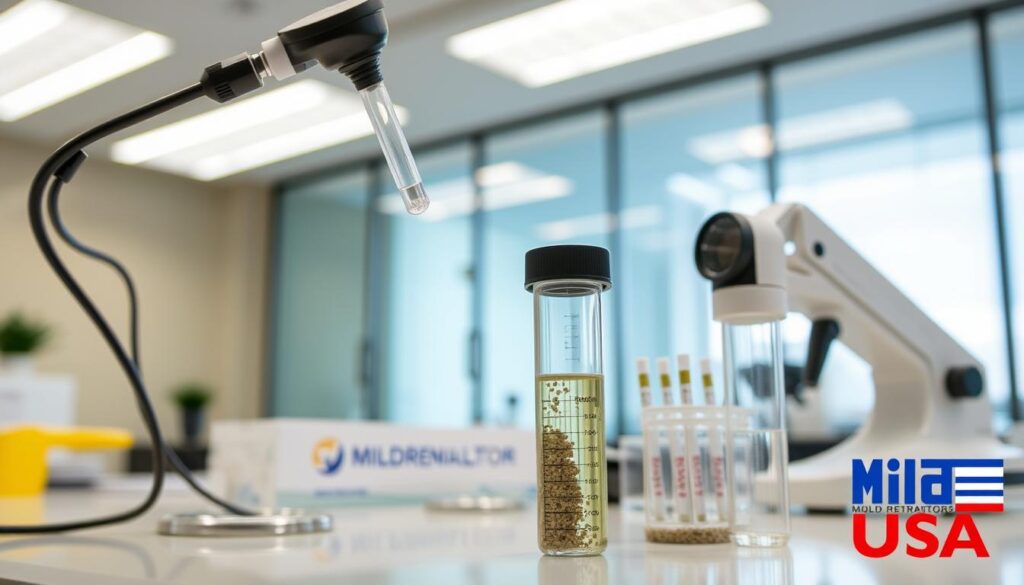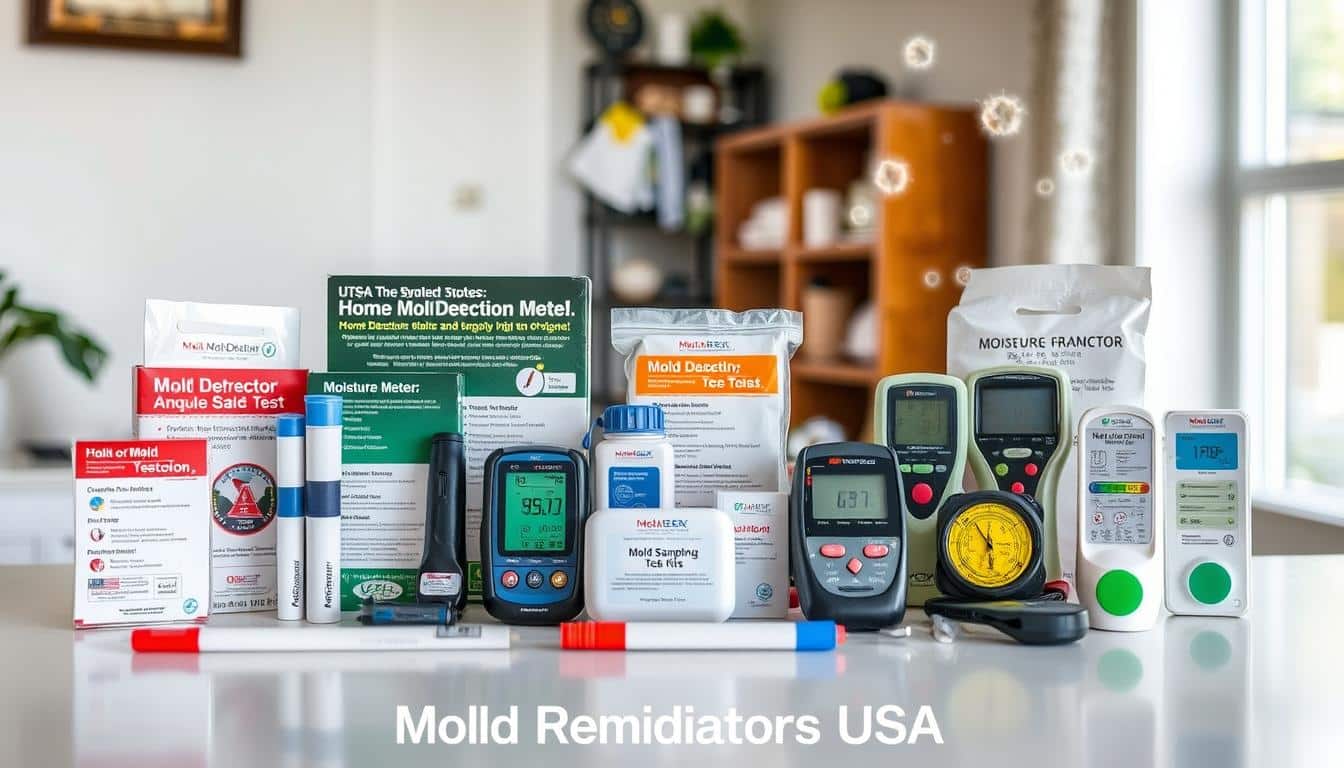Did you know mold can grow in temperatures from 40 to 100 degrees Fahrenheit? This makes most indoor places perfect for mold growth. As a homeowner, I’ve learned that DIY mold testing kits are a handy way to spot these hidden invaders.
These kits usually cost between $10 and $40, which is a budget-friendly start. They come with tools for both direct sampling and air sampling. This lets users test various spots of concern. They’re great for checking suspected mold, air quality, and even heating and cooling systems.
The Home Mold Laboratory Viable Mold Test Kit is just $12.99 and gives results in three to seven days. But, it’s important to remember these kits only show if mold is present. They don’t tell you why it’s there or what to do next. The Environmental Protection Agency suggests getting a professional mold check for a full review.
Now, let’s explore more about home mold testing. Here are some important points to remember.
Key Takeaways
- Home mold test kits offer affordable initial screening options
- Kits typically include tools for both surface and air sampling
- Results are usually available within a week of testing
- DIY kits may not provide comprehensive mold cause analysis
- Professional inspection is recommended for thorough assessment
- Mold can grow in a wide range of indoor temperatures
- Understanding mold detection methods is crucial for maintaining indoor air quality
Understanding Mold and Its Impact on Indoor Environments
Mold is a common problem in many homes. It can harm indoor air quality and health. Mold grows in damp, humid places, like wood and paper. Knowing how mold affects us is key to fixing it.
Common sources of indoor mold growth
Mold spores are everywhere in homes and outside. Places like bathrooms and kitchens are perfect for mold. To stop mold, fix leaks fast, use dehumidifiers, and turn on exhaust fans.
Health risks associated with mold exposure
Mold can cause many health problems. The CDC says it can lead to coughing, wheezing, and headaches. People with allergies or weak immune systems may get sicker from mold like Aspergillus.
The importance of early mold detection
Finding mold early is crucial for a healthy home. Regular checks can spot mold before it gets bad. Visible mold is easy to see, but hidden mold might need a pro to find. If you smell something musty or feel sick, get a mold check.
Preventing mold is the best way to control it. Fixing moisture issues and keeping air moving can help keep your home mold-free.
Types of Home Mold Test Kits Available
I’ve looked into many home mold test kits and I’m here to share what I found. These kits use different ways to find mold, like air and surface sampling. Let’s explore the choices for homeowners worried about mold inside their homes.

Air sampling kits are great for checking the air quality inside. The My Mold Detective kit lets you test 3 indoor and 1 outdoor sample. It costs about $90 on Amazon and Home Depot, with a $39 fee per sample and results in 3 days.
Surface sampling kits are for testing specific areas where mold might be. The Seeml Labs kit, priced at $34 on Amazon, tests 3 samples and comes with expert advice from an AIHA-accredited lab. You get your results the same day the lab gets your test.
For fast results, the Mold Armor DIY Mold Test Kit gives answers in 48 hours. It includes a swab and petri dish for both surface and air testing. The Evviva Sciences Mold Test Kit also offers results in 48 hours and comes with a guide to help you understand your results.
Some kits offer more detailed testing. The ImmunoLytics DIY Mold Test Kit has five petri dishes for testing different areas and pets. You can get professional lab analysis for a fee per dish if you need help interpreting the results.
| Test Kit | Type | Result Time | Price Range |
|---|---|---|---|
| My Mold Detective | Air Sampling | 3 days | $90 + $39/sample |
| Seeml Labs | Surface Sampling | Same day | $34 |
| Mold Armor | Air & Surface | 48 hours | Varies |
| ImmunoLytics | Comprehensive | 5-7 days | Varies |
Knowing about these options helps you pick the best mold detection method for your home. This ensures a safer place for you and your family.
How Do Home Mold Test Kits Work?
Home mold test kits are a handy way to find mold in your home. They use three main methods: checking the air, sampling the HVAC system, and testing surfaces. Let’s dive into how these kits work and what you can learn from the results.
Sample Collection Methods
These kits usually include a petri dish, swab, and mold growth medium for collecting sample. For air tests, you expose the petri dish to catch spores. To test surfaces, use the swab on moldy or suspicious spots. For HVAC tests, place the petri dish near vents.
Laboratory Analysis Process
After you collect samples, send them to a lab for mold identification. This process takes about 3 weeks and costs around $40 to find out the mold type. Labs use advanced methods like microscopy or DNA analysis to accurately identify mold species.
Interpreting Test Results
DIY test kits can show results in 48 hours. But, for a detailed air quality check, lab analysis is key. The reports tell you about mold types and how much is present, showing how serious the mold problem is in your home.
| Testing Method | Sample Collection | Result Time | Lab Analysis Required |
|---|---|---|---|
| Indoor Air Quality | Petri dish exposure | 48 hours | Optional |
| Surface Sampling | Swab on visible mold | 48 hours | Yes |
| HVAC Sampling | Petri dish near vents | 48 hours | Optional |
DIY kits are cheaper, costing $50-$100 per room, but might not be as accurate as professional tests. Professional tests can cost $200-$800 per hour but give more detailed results. Think about what you need before deciding on a mold detection method for your home.
Air Sampling Techniques for Mold Detection
Air sampling techniques are key for finding mold in homes. They help check air quality and find hidden mold. Let’s look at how air sampling works and why it’s vital for spotting mold.

Gravity sampling is a common method. It uses open petri dishes to catch falling mold spores over time. It’s a basic yet effective way to see airborne mold in a room. Another method uses air pumps to actively collect samples, which can be more detailed in catching airborne spores.
For mold in heating and cooling systems, there are special kits for air vents. These kits take samples while the system runs, showing mold issues in ductwork. This method is great for finding mold that’s not easy to see.
Air sampling is important for several reasons:
- It finds mold in places without visible growth
- It gives a full view of indoor air quality
- It checks if mold removal worked
While DIY air sampling kits are out there, they might not always be right because of wrong sampling methods. For better mold spore identification, think about getting help from professional mold testing services. These experts use the latest tools and methods for accurate air sampling and analysis.
Remember, regular mold testing is a smart move to find issues early. By knowing about air sampling techniques, you can keep your indoor space healthy and tackle mold problems before they get worse.
Surface Sampling Methods for Mold Identification
Surface sampling is key for finding mold in homes. It helps identify mold types on surfaces. This is important for fixing contamination problems.
Swab Sampling
Swab sampling uses sterile swabs to get mold samples from surfaces. It’s great for hard spots or when mold is easy to see.
Tape Lift Sampling
Tape lift sampling is a top choice for mold tests. It lets labs quickly spot mold types. This gives more info than air tests.
The Bio-Tape™ system makes samples consistent and safe from contamination. Always wear gloves and a mask when doing this test. Take samples where there’s water damage or mold.
Bulk Sampling
Bulk sampling takes a small piece of affected material for testing. It works well on materials like drywall. Samples are checked under a microscope to find mold types.
After taking samples, they go to a lab for analysis. Results come in 5-7 business days. This info is key for fixing mold problems. Mold can cause health issues like allergies and asthma.
| Sampling Method | Best Used For | Advantages |
|---|---|---|
| Swab Sampling | Hard-to-reach areas | Versatile, easy to use |
| Tape Lift Sampling | Visible mold growth | Quick identification, detailed data |
| Bulk Sampling | Porous materials | Comprehensive analysis |
DIY Mold Testing: Pros and Cons
I’ve explored DIY mold testing and home mold test kits. They seem appealing because they’re easy to use and save money. You can test whenever you want, without needing to schedule appointments. However, there are some downsides.
The accuracy of DIY mold testing is a big worry. More than 80% of home mold test kits give wrong results. Even Consumer Reports says four DIY mold test brands are not recommended. This makes their trustworthiness questionable.
Another issue is that many kits don’t include control samples. Without a sample from another area or outside, it’s tough to understand the results. Also, these kits often miss spores from harmful molds like Stachybotys and Chaetomium.
Yet, some experts think home mold test kits can be helpful for a first check, especially if you see mold. But they can’t replace professional testing. The EPA suggests that mold sampling should be done by experts with the right experience.
In my view, while DIY mold testing might seem attractive, it’s better as a starting point. For a detailed check, getting a professional mold inspector is the best choice. They have the right tools and knowledge to give accurate results and advice.
Professional Mold Testing vs. Home Test Kits
When it comes to finding mold in your home, you have two choices: professional mold testing or DIY home test kits. I’ve looked into both to help you decide what’s best for your home.
Accuracy and Reliability Comparisons
Professional mold testing is usually more accurate and reliable than home test kits. A mold inspector found that professional air samples gave more detailed info on mold types and counts than DIY kits. Home test kits often only show if mold is present, not much else.
The United States Environmental Protection Agency warns against using home mold test kits because they’re not very good. Consumer Reports says these kits are “Not Recommended” because they’re not accurate. On the other hand, professional mold testing uses experts and specific methods.
Cost Considerations
Professional mold testing costs more at first but can save you money later. Home test kits are cheaper but might lead to more expenses if they’re wrong or miss mold problems.
| Aspect | Professional Testing | Home Test Kits |
|---|---|---|
| Cost | Higher initial cost | Lower upfront cost |
| Accuracy | High | Variable |
| Comprehensive Analysis | Yes | Limited |
| Expert Consultation | Included | Not available |
When to Opt for Professional Testing
I suggest professional testing for big mold problems or health worries. Professional mold testing includes a detailed check, report, lab analysis, and advice on fixing the problem. It’s key for getting certified results for legal or insurance needs.
Home test kits might scare you without giving much value. If you try DIY, you might still need a pro for a full check. In the end, getting a professional mold inspector is the best way to keep your home and family safe from mold.
Common Mold Species Found in Homes
Exploring mold spore identification, I find many types of fungi in our homes. About 70% of U.S. homes have indoor mold. Knowing these invaders is key for effective mold removal.
Green molds are the most common, with over 185 types of Aspergillus fungi. Penicillium and Aspergillus have thousands of species that can grow in clean places. Cladosporium is also common, found on painted surfaces and wood, and can cause allergies and asthma.
In damp areas, Chaetomium and Stachybotrys chartarum, or “black mold,” can be found. These molds can damage structures and cause health issues.
For mold testing, air sampling is often used. Mold levels are measured in spores per cubic meter of air. Levels over 500 sp/m3 are considered high.
Collecting samples from different places in the home is important for a full assessment. While home mold test kits can give clues, they’re not always accurate. For a detailed analysis and effective removal, it’s best to get help from mold experts or Indoor Environmental Professionals (IEPs).
FAQ
What are some common sources of indoor mold growth?
Mold often grows in bathrooms, kitchens, and areas with water damage. It also thrives in places with poor ventilation. This is because mold loves damp, humid environments, especially where there are water leaks or flooding.
What health risks are associated with mold exposure?
Being exposed to mold can cause allergies and breathing problems like asthma. Some molds produce toxins that can harm people more severely.
Why is early mold detection important?
Finding mold early is key because it’s not always easy to see. Regular tests can spot mold early. This stops damage and health risks before they get worse.
What are the different types of home mold test kits available?
There are many types of home mold test kits. You can find air sampling kits, surface sampling kits, and all-in-one DIY kits. Each one is made for different needs and situations.
How do home mold test kits work?
Home mold test kits work by collecting and analyzing samples. You use tools to gather samples, then send them to labs. Labs use special methods to find out what mold is there and how much.
What are some air sampling techniques for mold detection?
To find mold in the air, you can use different methods. One way is to capture spores with petri dishes or air pumps. You can also test air systems by attaching kits to vents.
What are the different surface sampling methods for mold identification?
To find mold on surfaces, you can use swabs, tape, or take a bulk sample. Swabs are sterile, tape lifts spores, and bulk sampling takes a piece of the affected area.
What are the pros and cons of DIY mold testing?
DIY mold testing is cheap and easy to do. But, it might not be accurate if you don’t do it right. It also can’t do as much as a professional test can.
When should I opt for professional mold testing over home test kits?
If you have a lot of mold, health worries, or need results for legal reasons, get a pro. They are more accurate and do a full check, but it costs more.
What are some common mold species found in homes?
Homes often have Alternaria, Aspergillus, Penicillium, Stachybotrys chartarum (black mold), Cladosporium, and Mucor. Knowing these types helps you understand the risks and how to fix them.




